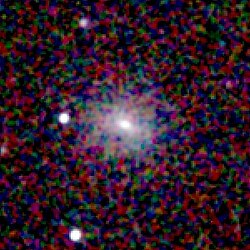| NGC 101 | |
|---|---|
 ESO KIDS image of NGC 101 | |
| Observation data (J2000 epoch) | |
| Constellation | Sculptor |
| Right ascension | 00h 23m 54.614s |
| Declination | −32° 32′ 10.34″ [1] |
| Redshift | 0.011284 [1] |
| Heliocentric radial velocity | 3383 [1] |
| Distance | 149.8 Mly (45.92 Mpc) [2] |
| Apparent magnitude (V) | 12.84 [1] |
| Apparent magnitude (B) | 13.36 [3] |
| Characteristics | |
| Type | SAB(rs)cd: [1] |
| Size | 119,200 ly (36,560 pc) [1] [note 1] |
| Apparent size (V) | 2.2′ × 2.0′ [1] |
| Other designations | |
| MGC-05-02-003, PGC 1518 [3] | |
NGC 101 is a spiral galaxy estimated to be about 150 million light-years away in the constellation of Sculptor. It was discovered by John Herschel in 1834 and its magnitude is 12.8. [4] It is a member of the Southern Supercluster (also called the Laniakea Supercluster) the closest galaxy supercluster to the Local Supercluster. [5]
